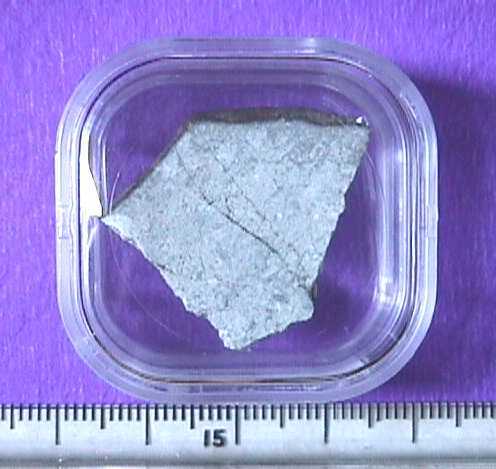
NWA 482 Lunar Anorthositic Impact Melt Breccia

2.162 gram fusion crusted part slice of NWA482 showing thin impact melt veins and white anorthositic clasts set in an predominantly anorthositic impact melt matrix.
NWA 482 is an extremely rare meteorite. Of all the meteorites thus far recovered, over 25,000, only 15 are of lunar origin. Though none have been observed to fall it is thought that less than one tenth of one percent of all the meteorites that fall might come from the moon. The mode of transfer is by asteroid-meteoroid impact. Though the moon is close to the earth, it would seem that more should come from that body, but the fact is that the dynamics of trajectories from the moon have to be very precise if rocks ejected from the lunar surface are ever to reach the earth. If too fast, they are accelerated to velocities by the Earth's gravity well that preclude them being captured by the Earth. Instead, they are flung out of the Earth-Moon system to assume their own orbits around the Sun, where they may or may not be captured by the Earth at a later time. If the ejection velocity is too slow, then they simply fall back to the moon. If however, the speed is such that they almost stop between the Moon and the Earth, with only a few meters per/sec in the Earth's favor then the Earth's gravity effects a capture and the chances of them falling to the Earth's surface vastly increases. Passage through the Earth's atmosphere undoubtedly destroys most of them, but a small fraction of these rocks do reach the surface.
Such was the case for NWA (North West Africa) 482, found by a nomad in Morocco or Algeria and later purchased by Jim Strope and Michael Farmer in December of 2000. The stone the recovered weighed 1015 grams, was oriented, and fully fusion crusted. Until cut, and examined with the proper scientific procedures and equipment there was nothing to indicate its lunar origin. But once cut, and properly examined, the mineralogy revealed intense shock, and impact melting that are the hallmarks of lunar rocks. Numerous impactors have over the eons bombarded the moon. Its surface has been thus churned and melted by these impacts resulting in a wide variety of impact melts and regolithic rocks. Lunar meteorites and the Apollo samples tell of an intense period of meteoroid bombardment of the Moon's surface 3.9 billion years ago. They also reveal other events subsequent to that period where the Moon's as well as the Earth's surface were pounded under these cosmic collisions. Unlike the Apollo samples, the lunar meteorites come from random locations, and offer a wide variety of sample types. Thus they are invaluable adjuncts to the Apollo samples in understanding the cosmic history of our nearest neighbor in space.
Of the lunar meteorites thus far recovered, NWA is unique for several reasons. Unlike the others that are weathered, NWA 482 is extremely fresh, and compares with the pristine Apollo samples. NWA is also whitish gray and is significantly higher in the mineral anorthosite, than the others. Anorthosite is a characteristic mineral found in the lunar highlands, and represents the oldest rocks found on the moon. The "Genesis Rock" that was found on the Apollo 16 mission is a prime example of lunar highland material.
NWA 482 is comparable to this and other Apollo lunar samples and it thus the subject of intense study with many reports still pending.
For more information on this amazing meteorite click this link: